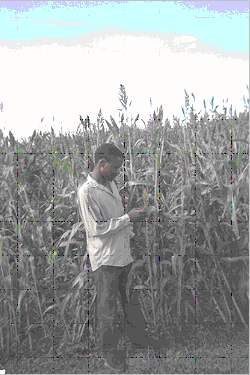Updated on 3rd March 2004 by JW
Demonstrating Increased
Resource Use Efficiency in the Sugar Industry of Southern Africa through
Environmentally Sustainable Energy Production.
Financed by the Common Fund for Commodities
 Caption: Sweet Sorghum at Lowveld
Research Station, in 1995, Zimbabwe.
Contacts: jeremy.woods@imperial.ac.uk
(Imperial College London, UK), Leonard
Nybanga (CRS, Zimbabwe), or Lindsay
Jolly (ISO, UK)
Caption: Sweet Sorghum at Lowveld
Research Station, in 1995, Zimbabwe.
Contacts: jeremy.woods@imperial.ac.uk
(Imperial College London, UK), Leonard
Nybanga (CRS, Zimbabwe), or Lindsay
Jolly (ISO, UK)
Project Progress Reports:
Current Status:
A new Fast-track project funded by the CFC began in November 2003 and is scheduled
for completion in June 2005. The project will establish, grow and process the
sweet sorghum from two trials, located in Zambia and managed by CEEEZ, Lusaka.
In total 30ha will be planted by small-holder farmers and a report on the potential
for the use of sweet sorghum in Nigeria will be provided.
The
project was successfully completed after the terminal workshop held in Harare,
September 2002. A 60 ha trial was harvested and crushed and processed
on the 15th March 2002.
A
final dissemination workshop was held in the beginning of September 2002 and
the workshop reports are being processed by the Common Fund for Commodities.
Overview & Links
Project Duration: 5 years (began 1st July 1997):
extended until August 2002
-
1997/8 10 ha trials at 2 sites
-
1998/9 10 ha trials at 2 sites
-
1998 60 ha planting & ethanol and CHP (plus: 7 ha Chiredzi,
3 ha Harare)
-
2000 / 01: Triangle Trial (60 ha) destroyed by mistake with
herbicide application (plus: 7 ha Chiredzi,
3 ha Harare continued)
- 2001 / 02: Triangle Ltd Trial (60 ha) hot weather and irrigation
problems disrupted water application. (plus 5ha CRS and 5 ha Harare).
Location: Chiredzi Research Station, Buffalo Range and Triangle Sugar Co. Ltd, Triangle, Zimbabwe
Technical visits by technicians/scientists from:
-
Kenya
-
Malawi
-
Mozambique
-
Tanzania
-
Zambia
Nature of Project: To demonstrate the feasibility
of co-cropping sweet sorghum with sugar cane (utilising fallow land) for
the production of energy. The project will develop a Methodology and Systems
Analysis Model to act as a decision support system for replication and
technology impacts.
Conduct an International Workshop at end of project.
Financing provided by CFC: US$ 628 344
Project Executing Agency (PEA): Science and Industry
Research and Development Centre (SIRDC), Harare, Zimbabwe.
Supervisory Body: International Sugar Organization
Contents: (for more details click on the links below)
Part
one
A. Background and Strategy
B. Wider (policy) objective:
C. Immediate objectives
D. Beneficiaries:
E. Conformity of objectives with the policies of the Common
Fund
Part
Two
F. The immediate objectives of the project
G. The scientific or technical problems to be addressed
and the feasibility of the proposed project
H. Economic and financial justification
I. Social Impact
J. Environmental Impact
Project
Implementation
K. The Work plan
Phase One (1st and 2nd years)
Phase Two (3rd year)
L. Project inputs
M. Risk
Management
of the project
O. The Project Executing Agency
P. Supervisory Body
Q. Monitoring, Reporting and Evaluation
References
Attachments
-
Attachment 1 Project Contribution to Sugar Development
Strategy 34
-
Attachment 2 The World Ethanol (Ethyl Alcohol) Market
35
-
Attachment 3 SIRDC (Scientific and Industrial Research
and Development Centre) 42
-
Attachment 4 Triangle Ltd. Zimbabwe 45
-
Attachment 5 Kings College London Overview & Personnel
47
-
Attachment 6 Systems Analysis and Computer Modelling 50
-
Attachment 7 The Environment: an Agricultural Point of
View for Sweet Sorghum Production 55
Back to Homepage

